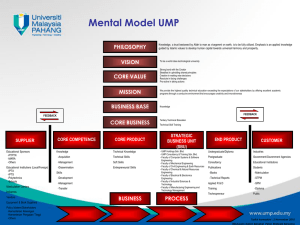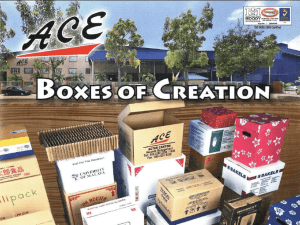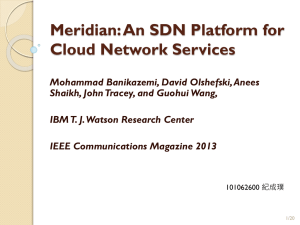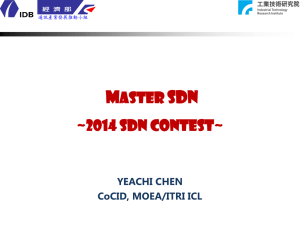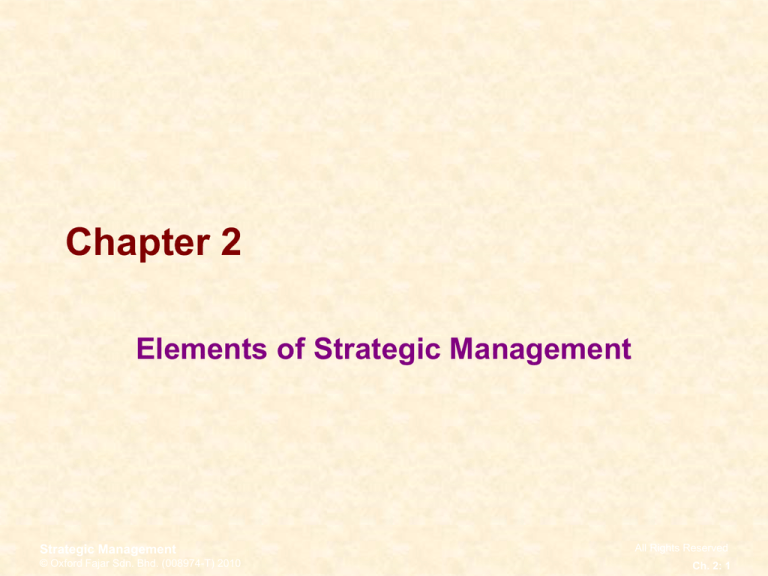
Chapter 2
Elements of Strategic Management
Strategic Management
© Oxford Fajar Sdn. Bhd. (008974-T) 2010
All Rights Reserved
Ch. 2: 1
LEARNING OBJECTIVES
After reading this chapter, you should be able to:
Define the key terms in strategic management:
competitive advantage, resources, capabilities, vision
and mission statements, objectives, strategies,
strategists, stakeholders, opportunities and threats,
and strengths and weaknesses.
Discuss different perspectives on competitive
advantage.
Identify different types of organizational resources.
Strategic Management
© Oxford Fajar Sdn. Bhd. (008974-T) 2010
All Rights Reserved
Ch. 2: 2
LEARNING OBJECTIVES (cont.)
Explain what makes organizational resources
unique.
Identify the components of a mission statement.
Identify the characteristics of an objective.
Identify and discuss components and levels of
strategies.
Explain different stakeholders of an organization.
Strategic Management
© Oxford Fajar Sdn. Bhd. (008974-T) 2010
All Rights Reserved
Ch. 2: 3
ELEMENTS OF STRATEGIC
MANAGEMENT
Some of the important elements of strategic
management are:
1.
2.
3.
4.
5.
6.
Competitive advantage
Sustained competitive advantage
Resource- based view
Industrial/organizational view
Resources and capabilities
Relationship between resources,
competitive advantage and strategy
7. Vision and mission statements
Strategic Management
© Oxford Fajar Sdn. Bhd. (008974-T) 2010
capabilities,
All Rights Reserved
Ch. 2: 4
ELEMENTS OF STRATEGIC
MANAGEMENT (cont.)
8.
9.
10.
11.
12.
13.
Objectives
Strategy
Strategist
Stakeholders
Opportunities and threats
Strengths and weaknesses
Strategic Management
© Oxford Fajar Sdn. Bhd. (008974-T) 2010
All Rights Reserved
Ch. 2: 5
1. Competitive Advantage
Firms strive to achieve a position that will enable
them to outperform its competitors and earn higher
revenue.
– E.g. DIGI, MAXIS,
companies, Ipad.
CELCOM,
smart
phones
Competitive Advantage refers to anything that a
firm does exceptionally well compared to its
competitors
Can include superior customer service, innovative
products, strong distribution channels or low pricing
– Something Unique that the firms offers.
Strategic Management
© Oxford Fajar Sdn. Bhd. (008974-T) 2010
All Rights Reserved
Ch. 2: 6
2. Sustained Competitive Advantage
Sustained competitive advantage comes from
maintaining higher profits than competitors over
long periods of time.
It is usually difficult for a company to develop a
sustained competitive advantage because of the
rapid changes in the environment.
Strategic Management
© Oxford Fajar Sdn. Bhd. (008974-T) 2010
All Rights Reserved
Ch. 2: 7
RBV vs I/O view
Views that enable the firms to achieve its
competitive advantage
Resource-based view
Strategic Management
© Oxford Fajar Sdn. Bhd. (008974-T) 2010
Industrial/Organizational
view
All Rights Reserved
Ch. 2: 8
3. Resource-based View
Takes the view that a firm’s internal resources are
more important than external factors for the firm to
achieve and sustain its competitive advantage
Internal resources:
– Skills, financial
resources.
resources,
HR
and
physical
Firms with superior resources and capabilities tend
to enjoy greater competitive advantage over other
firms.
When firm is able to develop its competencies
successfully from the resources it possesses –
competitive
advantage achieved.
Strategic
Management
All Rights Reserved
© Oxford Fajar Sdn. Bhd. (008974-T) 2010
Ch. 2: 9
3. Resource-based View
When firm is able to develop its competencies
successfully from the resources it possesses –
competitive advantage achieved.
Competencies
– Competence
– Core competence
– Distinctive competence
Strategic Management
© Oxford Fajar Sdn. Bhd. (008974-T) 2010
All Rights Reserved
Ch. 2: 10
4. Industrial/Organizational (I/O) View
Takes the opposing view from the resource-based
view theorists
I/O view contends that external factors are more
important than internal factors in a firm achieving
competitive advantage.
Able to avoid weak or faltering industries and
having full understanding of key external factors,
their relationships within that attractive industry
would be in more competitive advantageous
position.
Strategic Management
© Oxford Fajar Sdn. Bhd. (008974-T) 2010
All Rights Reserved
Ch. 2: 11
5. Resources and Capabilities
Resources refer to the inputs such as equipment,
human resources, processes, patents or finances
used by a firm to create its products or services.
Resources come from three categories:
– Tangible resources: the assets such as production
equipment, manufacturing or sales facilities, raw
materials and financial capital
– Intangible resources:
the firm’s reputation,
patents,
organization’s
culture,
knowledge,
technological know-how and copyrights
– Human resources: the skills, knowledge, abilities,
intelligence, experiences and competencies of the
organization’s employees
Strategic Management
© Oxford Fajar Sdn. Bhd. (008974-T) 2010
All Rights Reserved
Ch. 2: 12
5. Resources and Capabilities (cont.)
Characteristics of resources as a source of competitive advantage
Valuable
Does the resource create value for the firm in delivering the firm’s products or
services?
Rare
Is this resource rare or do current or potential competitor’s possess this
resource? In order to be a source of competitive advantage, a resource should
be both valuable and rare.
Hard to imitate and substitute
Is this resource difficult to imitate? Can my current and potential competitors
develop a substitute for this resource? Is this resource costly to imitate?
Organized to exploit
Does my firm have the necessary systems, policies, procedures and processes
to take full advantage of this resource in order to develop it into a competitive
advantage?
Strategic Management
© Oxford Fajar Sdn. Bhd. (008974-T) 2010
All Rights Reserved
Ch. 2: 13
5. Resources and Capabilities (cont.)
Capabilities refer to the firm’s capacity to
transform its resources into outputs valued by the
firm’s customers and which can generate profits for
the firm.
Strategic Management
© Oxford Fajar Sdn. Bhd. (008974-T) 2010
All Rights Reserved
Ch. 2: 14
6. Relationship between Resources,
Capabilities, Competitive Advantage and
Strategy
Resources
Competitive
Advantage
Strategy
Shapes
Transforms
Organizational
Capabilities
Strategic Management
© Oxford Fajar Sdn. Bhd. (008974-T) 2010
Builds
All Rights Reserved
Ch. 2: 15
7. Vision and Mission Statements
Vision and mission statements can often
be found in the firm’s annual report. They
are often placed in the front or beginning of
the annual report.
Most of the time they are displayed
throughout a firm’s premises and are
distributed with the company information
sent to constituencies.
Strategic Management
© Oxford Fajar Sdn. Bhd. (008974-T) 2010
All Rights Reserved
Ch. 2: 16
7. Vision and Mission Statements
(cont.)
Vision Statement
Vision statement is a statement about what the
organization wants to become – its guide,
shapes and give direction to the company.
A powerful motivator
A vision must be aligned with the core values of
both the individuals and the firm, and be
effectively communicated to and accepted by
everyone involved in the firm.
Developing a vision statement is the first step in
the strategic planning process.
Strategic Management
© Oxford Fajar Sdn. Bhd. (008974-T) 2010
All Rights Reserved
Ch. 2: 17
7. Vision and Mission Statements
(cont.)
A vision statement ranges in length from a couple of words
to several pages.
A short vision statement is recommended because the
employees will find it easy to remember a short
organizational vision and capture the firm’s aspirations and
strategic direction.
In addition, a vision statement has to be simple,
understandable and shared by everyone in the
organization. It must be sufficiently clear and concise that
everyone in the organization understands it.
Often used to describe the strategist’s plan for closing the
gap between current reality and a potential future.
Strategic Management
© Oxford Fajar Sdn. Bhd. (008974-T) 2010
All Rights Reserved
Ch. 2: 18
7. Vision and Mission Statements
(cont.)
Mission Statement
Mission statement is a statement which deals with
questions such as ‘What is our business?’, ‘Why are
we here?’ and ‘Why do we exist?’
It differs from vision statement as it refers not to the
future, but to the present.
A mission is concerned with the way an organization is
managed today, with its purpose or reason for being,
and also the purpose or reason for the organization’s
existence.
Strategic Management
© Oxford Fajar Sdn. Bhd. (008974-T) 2010
All Rights Reserved
Ch. 2: 19
7. Vision and Mission Statements
(cont.)
The mission statement also defines the
long-term vision of the organization in
terms of what it wants to be and whom it
wants to serve.
A firm’s mission statement should be clear
and concise in order to distinguish it from
any other firm.
It also has to be backed up with specific
objectives and strategies.
Strategic Management
© Oxford Fajar Sdn. Bhd. (008974-T) 2010
All Rights Reserved
Ch. 2: 20
7. Vision and Mission Statements
(cont.)
Components of Mission Statement
Mission statements can vary in length,
content, format and specificity
In general, an effective mission statement
exhibits nine components as follows:
Strategic Management
© Oxford Fajar Sdn. Bhd. (008974-T) 2010
All Rights Reserved
Ch. 2: 21
7. Vision and Mission Statements
(cont.)
1. Customers: Who are the firm’s customer?
2. Products or services: What are the firm’s major
products or services?
3. Markets: Geographically, where does the firm
compete?
4. Technology: Is the firm using the latest technology?
5. Concern for survival, growth and profitability: Is
the firm committed to growth and financial
soundness?
Strategic Management
© Oxford Fajar Sdn. Bhd. (008974-T) 2010
All Rights Reserved
Ch. 2: 22
7. Vision and Mission Statements
(cont.)
6. Philosophy: What are the basic beliefs, values,
aspirations and ethical priorities of the firm?
7. Self-concept: What is the firm’s distinctive
competence or major competitive advantage?
8. Concern for public image: Is the firm responsive to
social, community and environmental concerns?
9. Concern for employees: Are employees a valuable
asset to the firm?
Strategic Management
© Oxford Fajar Sdn. Bhd. (008974-T) 2010
All Rights Reserved
Ch. 2: 23
8. Objectives
An objective is a desired or specific result of a
planned activity that should be achieved by a
specific time.
The term goal is often used interchangeably
with the term objective. Some companies and
writers use the word goal in the same sense
that the word objective is used.
Strategic Management
© Oxford Fajar Sdn. Bhd. (008974-T) 2010
All Rights Reserved
Ch. 2: 24
8. Objectives (cont.)
Types
Objectives may be short, medium or long term.
Although there is no precise dividing point
among the three classes of objectives, many
would agree that one year or less refers to
short-term objectives whereas five years or
more refers to a long-term objective.
Strategic Management
© Oxford Fajar Sdn. Bhd. (008974-T) 2010
All Rights Reserved
Ch. 2: 25
8. Objectives (cont.)
An objective should be measurable in order for
the company to monitor its progress and make
corrections as needed.
Some of the characteristics of a good objective
are:
Specific, Measurable, Attainable/achievable,
Realistic and Time-phased (SMART).
Strategic Management
© Oxford Fajar Sdn. Bhd. (008974-T) 2010
All Rights Reserved
Ch. 2: 26
9. Strategy
A strategy of an organization forms a
comprehensive master plan that states how the
corporation will achieve its mission and
objectives.
It maximizes competitive advantage
minimizes competitive disadvantage.
and
It is concerned with integrating company
activities and allocating resources so that the
present objective can be met.
Strategic Management
© Oxford Fajar Sdn. Bhd. (008974-T) 2010
All Rights Reserved
Ch. 2: 27
9. Strategy
When planning strategies, decisions are not
taken in a vacuum, but that any action taken in
a business firm is likely to be met by a reaction
from those affected:
Competitors, Customers, labour force or
suppliers.
It is critical, the effects in such reactions should
be evaluated before taking decision.
Strategic Management
© Oxford Fajar Sdn. Bhd. (008974-T) 2010
All Rights Reserved
Ch. 2: 28
9. Strategy (cont.)
Levels of Strategies
The typical business firm usually considers three levels of
strategy: corporate, business and functional
Strategic Management
© Oxford Fajar Sdn. Bhd. (008974-T) 2010
All Rights Reserved
Ch. 2: 29
9. Strategy (cont.)
A. Corporate Level Strategies
Corporate level strategies are meant to be
considered for the overall movement of the
organization and the decisions have to be made
at the top corporate level with the inputs and
participation from the various divisions.
E.g. UNITEN as the University
It typically fits within the three main categories of
stability, growth and retrenchment.
Strategic Management
© Oxford Fajar Sdn. Bhd. (008974-T) 2010
All Rights Reserved
Ch. 2: 30
9. Strategy (cont.)
B. Business Level Strategies
Business level strategies usually occur at the
business unit or product level. They emphasize
on the improvement of the competitive position of
a corporation’s products or services in the specific
industry or market segment served by that
business unit.
E.g. CoIT as the business unit
The business strategies are grouped into three
generic strategies: cost leadership, differentiation
and focus.
Strategic Management
© Oxford Fajar Sdn. Bhd. (008974-T) 2010
All Rights Reserved
Ch. 2: 31
9. Strategy (cont.)
C. Functional Level Strategies
Functional
strategies
(also
known
as
departmental level strategies) are the actions to
be considered at the various functional or
operational levels of the organization.
E.g. IS department,
Technician dept.
admin
department,
The strategic issues at the functional level
actually are related to business processes and
the value chain.
Strategic Management
© Oxford Fajar Sdn. Bhd. (008974-T) 2010
All Rights Reserved
Ch. 2: 32
9. Strategy (cont.)
C. Functional Level Strategies
The organization have to look at its
management, marketing, financial and operation
divisions to assist in realizing the overall
corporate level strategy that has been decided.
Strategic Management
© Oxford Fajar Sdn. Bhd. (008974-T) 2010
All Rights Reserved
Ch. 2: 33
10. Strategist (reading)
The strategist is a skilful person in designing
and planning action and policy to achieve a
major or overall aim.
They are also the individuals who are most
responsible for the success or failure of an
organization.
The strategists have various job titles such as
chief executive officer (CEO), president, owner
of the firm, chair of the board, executive
director, chancellor, dean or entrepreneur.
Strategic Management
© Oxford Fajar Sdn. Bhd. (008974-T) 2010
All Rights Reserved
Ch. 2: 34
10. Strategist (cont.)
A strategist helps an organization to gather,
analyse and organise information.
He or she tracks industry and competitive
trends, develop forecasting models and
scenario analyses, evaluate corporate and
divisional performance, spot emerging market
opportunities, identify business threats, etc.
Strategic Management
© Oxford Fajar Sdn. Bhd. (008974-T) 2010
All Rights Reserved
Ch. 2: 35
11. Stakeholders (reading)
Stakeholders refer to individuals or groups who can
affect or is affected by the organization’s actions,
decisions, policies or practices.
Groups
Primary stakeholders
Secondary stakeholders
Strategic Management
© Oxford Fajar Sdn. Bhd. (008974-T) 2010
All Rights Reserved
Ch. 2: 36
11. Stakeholders (cont.)
Source: Steiner, G.A. and Steiner,
J.F. (2006), Business,
Government and Society:
A Managerial Perspective, Text
and Cases, New York: McGrawHill/Irwin, p. 17.
Strategic Management
© Oxford Fajar Sdn. Bhd. (008974-T) 2010
All Rights Reserved
Ch. 2: 37
12. Opportunities and Threats
External environment forces such as political, legal,
economic, social, technological and the competitive
environment can harm or benefit the organization.
Opportunities and threats refer to factors beyond
the control of a firm and hence are largely external.
Opportunities refer to external environmental
factors such as political, legal, economic, social or
technological factors that can help the organization
in achieving its objectives.
Strategic Management
© Oxford Fajar Sdn. Bhd. (008974-T) 2010
All Rights Reserved
Ch. 2: 38
12. Opportunities and Threats
Threats are the external environment forces that
can impede a firm’s efforts to achieve its
objectives.
Strategic Management
© Oxford Fajar Sdn. Bhd. (008974-T) 2010
All Rights Reserved
Ch. 2: 39
13. Strengths and
Weaknesses
Strengths and weaknesses are the two internal,
controllable activities/variables performed especially
well or poorly in an organization.
A strength is defined as anything internal to the
company that may lead to an advantage relative to
competitors and a benefit relative to customers.
In general, strengths and weaknesses are typically
located in functional areas of the firm such as
management, marketing, finance and accounting,
production/operation, research and development
(R&D), and computer information system (CIS).
Strategic Management
© Oxford Fajar Sdn. Bhd. (008974-T) 2010
All Rights Reserved
Ch. 2: 40
13. Strengths and
Weaknesses (cont.)
Strengths refer to the competitive advantages
and other distinctive competencies that a
company can exert in the marketplace.
Conversely, weakness is defined as anything
internal that may lead to a disadvantage
relative to competitors and customers.
Therefore, a firm should play on its strengths
while
improving
on
its
weaknesses,
presupposing that a firm knows its current
position.
Strategic Management
© Oxford Fajar Sdn. Bhd. (008974-T) 2010
All Rights Reserved
Ch. 2: 41
Reference
Zainal Abidin Mohamed, Jo Ann Ho, Foong Yee
Wong (2010) “Strategic Management” ,Oxford
University
Press,
ISBN
9834509588,
9789834509583
Strategic Management
© Oxford Fajar Sdn. Bhd. (008974-T) 2010
All Rights Reserved
Ch. 2: 42


